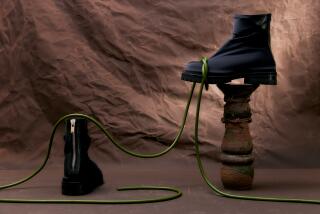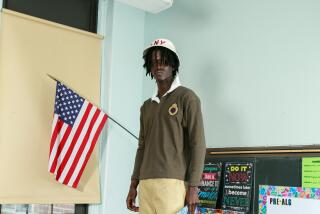Supreme brand celebrates its first 25 years with new photo-filled book
- Share via
Before it collaborated with the world’s largest luxury brand, Louis Vuitton, or was valued as a billion-dollar business by profit-hungry investors, Supreme was a sleepy shop in downtown New York that sold clothes to stoned skateboarders. (A second North America location opened on Fairfax Avenue in Los Angeles in 2004.)
Its founder, James Jebbia, an American who was raised in England until he was 19, was building a reputation by 1994 — the year Supreme was founded — as a savvy retailer with his fingers on the pulse of a younger generation. He had already opened a shop called Union (yes, that one) and another with a surfer-designer by the name of Shawn Stüssy (yes, that one).
“A lot of kids who worked for me skated, but it seemed to me that there were no skate shops around,” Jebbia, who is notoriously press-shy, told Interview magazine in 2009. “So I was like, ‘OK, cool, maybe I’ll do a skate shop.’ It cost me, like, $12,000 to open the store.’”
It’s hard to quantify the influence Supreme has had during the last quarter century. For a start, it’s been instrumental in pushing streetwear from the underground into the mainstream, defining how a generation of men relate to fashion, foreshadowing the death of the suit, and popularizing the “drop” system of releasing limited-edition product on a semi-regular basis (as opposed to the fashion industry’s fusty seasonal model).
Still, the new book “Supreme” ($49.95) from Phaidon, the publisher of lavish coffee-table books, takes a swing at it. The fact is, Supreme isn’t merely a clothing label. It’s a status symbol, one of the few brands that has crossed over from making garments to serving as a cultural signifier of a certain milieu. Like Hermès or Chanel, Supreme is not so much about clothing as it is the symbol of a type of lifestyle.
The book makes little use of words and instead serves mostly as a visual chronicle, a nostalgia-tinged look at a subculture’s dramas playing out amid a changing city and the internet era waiting to replace these hazy pre-digital days.
There are enough buzzy names to secure Supreme as an influential arbiter of taste: photographs by Larry Clark and director Harmony Korine, the now iconic image of Kate Moss in a Supreme box logo shirt and cheetah print coat, holding a smoldering cigarette shot by Alasdair McLellan. (Perennial “It” girl and fashion plate Chloë Sevigny also shows up, of course.)
Supreme has collaborated with a roster of impressive names who are also represented in the book, including artist Cindy Sherman, photographer Nan Goldin and brands such as the avant-garde Comme des Garçons and the sneaker and sportswear behemoth Nike. All of which is to say that Supreme isn’t a closed-off entity but a porous one. And its success and enduring relevance rely openly on tenets of community and collaboration.
Jebbia is now 56 years old and has a CFDA Award for best menswear designer under his belt. (In his acceptance speech, he said, “I’ve never considered Supreme to be a fashion company or myself a designer.”) The brand’s famous stealth is slowly eroding; in recent years it’s had lengthy profiles in GQ and Vogue. It’s safe to say that Supreme and its designer are no longer underground — they’re part of a mainstream they helped create. All of which makes looking through the grainy photographs of shaggy-haired street kids wearing baggy clothes and doing skate tricks a bit wistful but not sentimental.
There’s a thread of nostalgia that weaves itself through the book’s first half (the last third is mostly pictures of look books from recent collections). Today, to achieve the influence Supreme has accumulated, one would need social media strategists, paid influencer marketing and venture-capital funding. Back then you just needed a couple of cool kids and some word of mouth.
“Twenty-five years into an impromptu yet intuitive project that has grown from cottage industry to international trade, the success of Supreme has earned it widespread recognition as a major force and paradigmatic apogee in myriad fields, including design, fashion, art, street style and branding identity,” writes cultural critic Carlo McCormick in the book’s introduction. “But putting such accolades aside, Supreme was and will always remain a fundamental, unflinching expression of skate culture.”
More to Read
Sign up for The Wild
We’ll help you find the best places to hike, bike and run, as well as the perfect silent spots for meditation and yoga.
You may occasionally receive promotional content from the Los Angeles Times.










